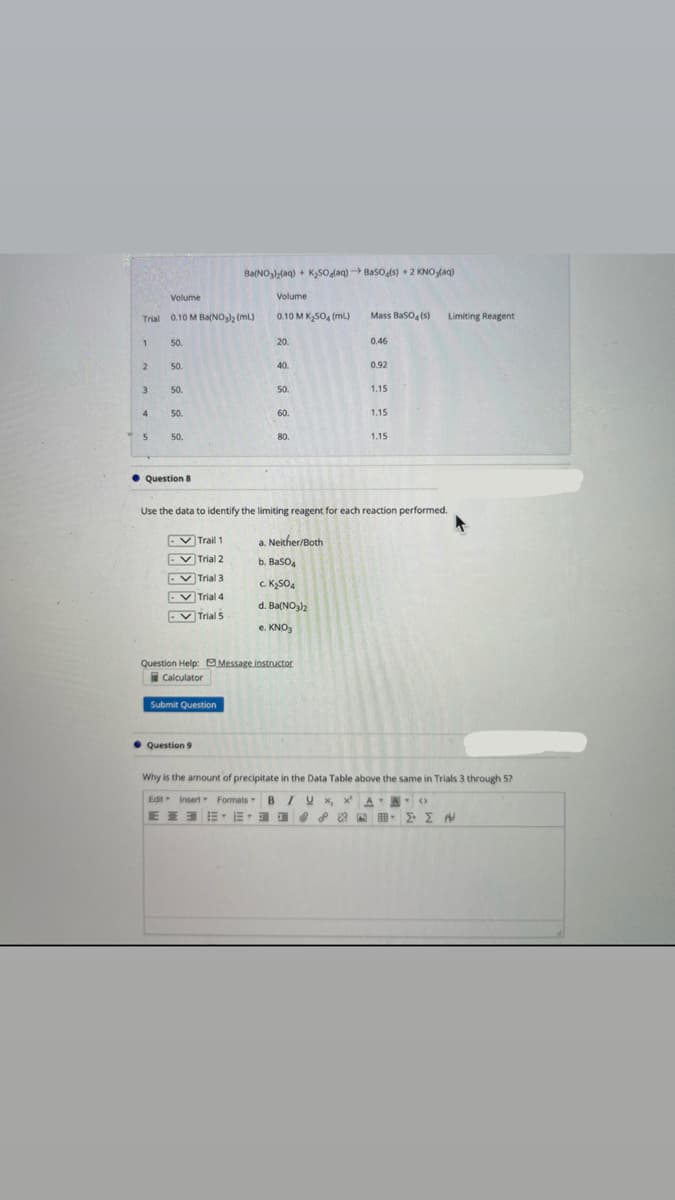Ba(NO,ly(aq) + K,SOlaq)Baso(s) +2 KNOlaq) Volume Volume Trial 0.10 M Ba(NO,)2 (ml) 0.10 M K,SO, (ml) Mass Baso, (s) Limiting Reagent 50. 20. 0.46 2. 50. 40. 0.92 50. 50. 1.15 4 50. 60. 1.15 50. 80. 1.15 Question 8 Use the data to identify the limiting reagent for each reaction performed. Trail 1 a. Neither/Both Trial 2 b. Baso4 V Trial 3 C. KSO4 V Trial 4 d. Ba(NO,)2 Trial 5 e. KNO,
Ba(NO,ly(aq) + K,SOlaq)Baso(s) +2 KNOlaq) Volume Volume Trial 0.10 M Ba(NO,)2 (ml) 0.10 M K,SO, (ml) Mass Baso, (s) Limiting Reagent 50. 20. 0.46 2. 50. 40. 0.92 50. 50. 1.15 4 50. 60. 1.15 50. 80. 1.15 Question 8 Use the data to identify the limiting reagent for each reaction performed. Trail 1 a. Neither/Both Trial 2 b. Baso4 V Trial 3 C. KSO4 V Trial 4 d. Ba(NO,)2 Trial 5 e. KNO,
Chemistry
10th Edition
ISBN:9781305957404
Author:Steven S. Zumdahl, Susan A. Zumdahl, Donald J. DeCoste
Publisher:Steven S. Zumdahl, Susan A. Zumdahl, Donald J. DeCoste
Chapter1: Chemical Foundations
Section: Chapter Questions
Problem 1RQ: Define and explain the differences between the following terms. a. law and theory b. theory and...
Related questions
Question

Transcribed Image Text:Ba(NO,l(aq) + K,SOlaq) Baso(s) + 2 KNOlaq)
Volume
Volume
Trial 0.10 M Ba(NO)2 (ml)
0.10 M K,SO, (ml)
Mass Baso4 (s)
Limiting Reagent
50.
20.
0.46
50.
40.
0.92
3
50.
50.
1.15
4
50.
60.
1.15
50.
80.
1.15
• Question 8
Use the data to identify the limiting reagent for each reaction performed.
V Trail 1
a. Neither/Both
EV Trial 2
b. Baso4
EV Trial 3
C. KSO4
EV Trial 4
d. Ba(NO3)2
EV Trial 5
e. KNO3
Question Help: Message instructor
I Calculator
Submit Question
• Question 9
Why is the amount of precipitate in the Data Table above the same in Trials 3 through 5?
Edit Insert Formats B IVX x' A
Expert Solution
This question has been solved!
Explore an expertly crafted, step-by-step solution for a thorough understanding of key concepts.
Step by step
Solved in 2 steps with 2 images

Knowledge Booster
Learn more about
Need a deep-dive on the concept behind this application? Look no further. Learn more about this topic, chemistry and related others by exploring similar questions and additional content below.Recommended textbooks for you

Chemistry
Chemistry
ISBN:
9781305957404
Author:
Steven S. Zumdahl, Susan A. Zumdahl, Donald J. DeCoste
Publisher:
Cengage Learning

Chemistry
Chemistry
ISBN:
9781259911156
Author:
Raymond Chang Dr., Jason Overby Professor
Publisher:
McGraw-Hill Education

Principles of Instrumental Analysis
Chemistry
ISBN:
9781305577213
Author:
Douglas A. Skoog, F. James Holler, Stanley R. Crouch
Publisher:
Cengage Learning

Chemistry
Chemistry
ISBN:
9781305957404
Author:
Steven S. Zumdahl, Susan A. Zumdahl, Donald J. DeCoste
Publisher:
Cengage Learning

Chemistry
Chemistry
ISBN:
9781259911156
Author:
Raymond Chang Dr., Jason Overby Professor
Publisher:
McGraw-Hill Education

Principles of Instrumental Analysis
Chemistry
ISBN:
9781305577213
Author:
Douglas A. Skoog, F. James Holler, Stanley R. Crouch
Publisher:
Cengage Learning

Organic Chemistry
Chemistry
ISBN:
9780078021558
Author:
Janice Gorzynski Smith Dr.
Publisher:
McGraw-Hill Education

Chemistry: Principles and Reactions
Chemistry
ISBN:
9781305079373
Author:
William L. Masterton, Cecile N. Hurley
Publisher:
Cengage Learning

Elementary Principles of Chemical Processes, Bind…
Chemistry
ISBN:
9781118431221
Author:
Richard M. Felder, Ronald W. Rousseau, Lisa G. Bullard
Publisher:
WILEY